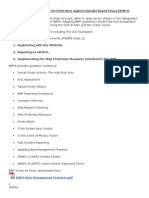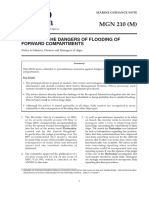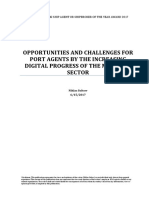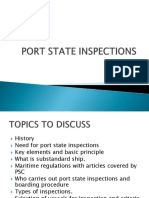0 ratings0% found this document useful (0 votes)
228 viewsHow Can We Prevent Collision at Sea?
How Can We Prevent Collision at Sea?
Uploaded by
Haeisy Simsuangco1. Keeping a constant lookout, being visible, knowing signals and using proper equipment can help prevent collisions at sea. Following proper procedures after a collision, like stopping engines and assessing damage, can minimize risks.
2. The COLREG establishes rules to avoid collisions, which are important given increased ship traffic.
3. After grounding, immediate steps include stopping engines, sounding alarms, reporting the incident and assessing damage to determine next steps around safety, pollution risks and needing assistance.
Copyright:
© All Rights Reserved
Available Formats
Download as DOCX, PDF, TXT or read online from Scribd
How Can We Prevent Collision at Sea?
How Can We Prevent Collision at Sea?
Uploaded by
Haeisy Simsuangco0 ratings0% found this document useful (0 votes)
228 views5 pages1. Keeping a constant lookout, being visible, knowing signals and using proper equipment can help prevent collisions at sea. Following proper procedures after a collision, like stopping engines and assessing damage, can minimize risks.
2. The COLREG establishes rules to avoid collisions, which are important given increased ship traffic.
3. After grounding, immediate steps include stopping engines, sounding alarms, reporting the incident and assessing damage to determine next steps around safety, pollution risks and needing assistance.
Original Title
SEAM 5 ACTIVITY 16
Copyright
© © All Rights Reserved
Available Formats
DOCX, PDF, TXT or read online from Scribd
Share this document
Did you find this document useful?
Is this content inappropriate?
1. Keeping a constant lookout, being visible, knowing signals and using proper equipment can help prevent collisions at sea. Following proper procedures after a collision, like stopping engines and assessing damage, can minimize risks.
2. The COLREG establishes rules to avoid collisions, which are important given increased ship traffic.
3. After grounding, immediate steps include stopping engines, sounding alarms, reporting the incident and assessing damage to determine next steps around safety, pollution risks and needing assistance.
Copyright:
© All Rights Reserved
Available Formats
Download as DOCX, PDF, TXT or read online from Scribd
Download as docx, pdf, or txt
0 ratings0% found this document useful (0 votes)
228 views5 pagesHow Can We Prevent Collision at Sea?
How Can We Prevent Collision at Sea?
Uploaded by
Haeisy Simsuangco1. Keeping a constant lookout, being visible, knowing signals and using proper equipment can help prevent collisions at sea. Following proper procedures after a collision, like stopping engines and assessing damage, can minimize risks.
2. The COLREG establishes rules to avoid collisions, which are important given increased ship traffic.
3. After grounding, immediate steps include stopping engines, sounding alarms, reporting the incident and assessing damage to determine next steps around safety, pollution risks and needing assistance.
Copyright:
© All Rights Reserved
Available Formats
Download as DOCX, PDF, TXT or read online from Scribd
Download as docx, pdf, or txt
You are on page 1of 5
<< Week No.
16 >>
<< Actions on Collision and Grounding >>
Define the following questions:
1. How can we prevent collision at sea?
What Can You Do?
Keep a constant lookout
Stay out of the way
Do not underestimate the speed of a large vessel
Be visible
Keep watch at night
Watch the ship's lights
Know whistle signals
Use your radio
Choose safe anchorages
Use binoculars
Carry a radar reflector
Remember that ships displace many thousands of tons of water
Note that around some restricted areas
2. Why is COLREG important?
The COLREG is important because it aims to establish rules to avoid
collision at sea. The increasing number of ships and condensed traffic on
the sea lines of communication makes the COLREGs rather important for
safety of the seas.
3. What action should be taken following a vessel on collision?
1. Stop engines and obtain an assessment of the situation. ...
2. Sound emergency alarm.
3. Switch on deck lights and NUC lights.
4. Inform master & engine room .
5. Broadcast message to all ships in the vicinity.
6. Carry out head count and damage assessment.
7. Muster damage control parties and detail duties
8. Order bilge pumps and ballast pumps to start pumping out effected area.
9. Shut all watertight doors and fire doors.
10. Communication officer- standby to obtain weather report.
Navigational officer to update vessels position and assist master as
required.
11. Prepare survival craft for immediate launching if situation demands.
4. What are the causes of ship collision?
Long Hours, Lack of sleep leading to Fatigue
Inexperience, and lack of training
Long voyages, extended time at sea
Personal relationships aboard the vessel
Reckless Behavior, including abuse of drugs and alcohol
Poor decision making and/or negligence
Pressures and stress of Job Duties
5. How do you stop a ship collision?
Collision Avoidance Checklist
Avoid ship channels where possible, or cross them quickly.
Be alert: Watch for ship traffic.
Think before you drink!
Be seen, especially at night.
Know whistle signals: Five or more mean danger.
Use radio channel 13 for bridge-to-bridge communication.
Use up-to-date navigation charts.
Keep in mind that few survive collisions with ships.
When in doubt, keep clear.
6. What is the difference between stranding and grounding?
A grounding is when a ship strikes the seabed, while a stranding is when
the ship then remains there for some length of time. Both can damage a
vessel and result in oil spills depending on the ocean bottom type. A vessel
is stranded when she is aground and cannot refloat without assistance. A
grounding may be accidental or may be anticipated, e. g. at ports and
berths where ships are expected to take the ground whilst alongside.
7. How do you stop a ship from grounding?
Best Practice to Stop Grounding:
Proper Passage Planning
Vigilant Watchkeeping
Regular Position Fixing
Good Bridge Resource Management
Fatigue Management
Avoiding Complacency
Superintendence
Mentoring
8. What does it mean when a ship is grounded?
Ship grounding or ship stranding is the impact of a ship on seabed or
waterway side.[1] It may be intentional, as in beaching to land crew or
cargo, and careening, for maintenance or repair, or unintentional, as in a
marine accident. In accidental cases, it is commonly referred to as
"running aground".
When unintentional, grounding may result simply in stranding, with or
without damage to the submerged part of the ship's hull. Breach of the hull
may lead to significant flooding, which in the absence of containment in
watertight bulkheads may substantially compromise the ship's structural
integrity, stability, and safety.
9. What is the first step after running aground?
-Stop engines immediately (it happens that a ship runs aground with very
little speed on a very soft bottom with very little slope) and that nobody on
the bridge or in the engine room has felt it)
-Sound general alarm
-Watertight doors to be closed
-VHF watch maintained on channel 16
-Broadcast to other vessels
-Sound signals, Light / Shapes to be exhibited especially important in case
of fog)
-Deck lighting switched on
-Check position on chart
-Take note of any valuable information (time, course steered, speed, log,
eventual manoeuvres, etc.)
-Sound bilges, tanks
-Immediately take overboard soundings around vessel to check on what
type of sandbank the ship is lying.
-If the ship is on top of a flat sandbank the danger of breaking in two is
minimal.
-Evaluate risks of pollution
-Inform Company and any third parties if relevant (P & I Club, Hull
underwriters, Port authorities, etc)
-Update if necessary vessel's position in radio room, satellite terminal and
other automatic distress transmitter (GMDSS)
-Consider danger of the situation and if possible take pictures
-Consider further actions with consideration for:
salvage
risks of sinking (emergency message, EPIRB's, abandon ship)
secure position (change of tide, weather, stream, stress risks, stability)
assistance, port of refuge, oil spills
Keep the Company always informed
Enter every action taken in the log book
10. What does it mean to ground a ship?
Ship grounding occurs when a sea vessel such as a boat or tanker runs
aground or otherwise makes contact with the bed of the body of water.
This occurrence often has a significant structural impact on the ship itself,
and a ship grounding may also lead to a loss of human life or
environmental distress. The structural damage to the ship may be
catastrophic, or it may be minor enough that the ship can continue to
function, but a thorough inspection of the ship will be necessary after such
an impact.
The dangers associated with a ship grounding vary according to the vessel
and the situation that led to the impact. In some cases, a ship grounding
can lead to the vessel being stranded on the bed that it contacted, leading
to a difficult process to free the vessel or otherwise repair it. The damage
incurred by the vessel may allow water to flood the lower part of the boat,
which can be a potentially dangerous and life threatening situation. Ships
can sink as a result of a ship grounding, and loss of human life on board
the vessel is possible.
You might also like
- Master Standing Order For Ship's CaptainDocument3 pagesMaster Standing Order For Ship's CaptainCapt. Suzdayan87% (54)
- Bridge Watch Keeping QuestionsDocument27 pagesBridge Watch Keeping QuestionsJohn O'Regan80% (5)
- The Tau FleetDocument21 pagesThe Tau FleetTanner Yea67% (3)
- Master Standing OrderDocument1 pageMaster Standing OrderDavid Durham100% (2)
- Beaching ProcedureDocument11 pagesBeaching ProcedureSatya Prakash Bhardwaj0% (1)
- Collision Regulation AnalysisDocument29 pagesCollision Regulation AnalysisBernard Mamora100% (1)
- Passenger Sheips RINADocument11 pagesPassenger Sheips RINAGoran JurisicNo ratings yet
- Class 1 CoC Deck SingaporeDocument66 pagesClass 1 CoC Deck SingaporeImran Alam Satti100% (7)
- Standing OrderDocument3 pagesStanding OrderReza Zain100% (1)
- Piloting, Seamanship and Small Boat Handling - Vol. VFrom EverandPiloting, Seamanship and Small Boat Handling - Vol. VRating: 5 out of 5 stars5/5 (2)
- A Learning Module Engineering Watchkeeping (Ewatch)Document12 pagesA Learning Module Engineering Watchkeeping (Ewatch)marpel100% (2)
- Sopep Manual - ExampleDocument51 pagesSopep Manual - Examplelelakijahat1234100% (14)
- Meeting 21 Bahasa Inggris Maritim ANT 2Document6 pagesMeeting 21 Bahasa Inggris Maritim ANT 2Mukhlis NugrahaNo ratings yet
- Collision & GroundingDocument12 pagesCollision & GroundingAiro Nikko SolpicoNo ratings yet
- Emergencies Note by Capt. Kyaw Mya OoDocument72 pagesEmergencies Note by Capt. Kyaw Mya OoKyaw Mya OoNo ratings yet
- 1143Document7 pages1143ncharalaNo ratings yet
- Meeting 23 Bahasa Inggris Maritim ANT 2Document14 pagesMeeting 23 Bahasa Inggris Maritim ANT 2Mukhlis Nugraha100% (1)
- CH 11 Stranding and BeachingDocument7 pagesCH 11 Stranding and BeachingAmit PandeyNo ratings yet
- MGMT 1 MIDTERM RESEARCH G 4 OralDocument4 pagesMGMT 1 MIDTERM RESEARCH G 4 OralAdrian ViejoNo ratings yet
- Actions To Be Taken Following A CollisionDocument37 pagesActions To Be Taken Following A CollisionSalvador Jr. Besares100% (6)
- Crisis ManagementDocument14 pagesCrisis ManagementJayesh SolaskarNo ratings yet
- When Your Ship Is Dragging AnchorDocument9 pagesWhen Your Ship Is Dragging AnchorGAMMA FACULTY100% (1)
- INSTRUCTIONAL MATERIALS-PPT - DL - pptx.pdf-1687309099.INSTRUCTIONAL MATERIALS-PPT - DLDocument220 pagesINSTRUCTIONAL MATERIALS-PPT - DL - pptx.pdf-1687309099.INSTRUCTIONAL MATERIALS-PPT - DLKervs LegaspiNo ratings yet
- EM II, s1, PDFDocument30 pagesEM II, s1, PDFAbduraman LeventNo ratings yet
- MGMT 1 Output Midterm G 4Document12 pagesMGMT 1 Output Midterm G 4Adrian ViejoNo ratings yet
- Grounding Checklist - Attachment XXXVIDocument4 pagesGrounding Checklist - Attachment XXXVIFaiqah AzmirNo ratings yet
- S5.1 IntroductionDocument7 pagesS5.1 IntroductionzikriNo ratings yet
- Republic of The Marshall Islands Office of The Maritime AdministratorDocument6 pagesRepublic of The Marshall Islands Office of The Maritime AdministratorPolaris BridgemanNo ratings yet
- Reporting in Seam5 Group 3Document5 pagesReporting in Seam5 Group 3Frednixen GapoyNo ratings yet
- Prepration For Heavy Weather at ....Document2 pagesPrepration For Heavy Weather at ....shyam subramaniNo ratings yet
- BWK Lo 2Document18 pagesBWK Lo 2Roshan MaindanNo ratings yet
- Master Unlimited Oral Capt SaatDocument7 pagesMaster Unlimited Oral Capt SaatIngat MatiNo ratings yet
- 10 Important Things To Do During Ship Collision AccidentDocument14 pages10 Important Things To Do During Ship Collision AccidentE BarajasNo ratings yet
- Ship Handling and Manuevering: SEA 305 BDocument32 pagesShip Handling and Manuevering: SEA 305 BAnthony Steve LomilloNo ratings yet
- Codes - Standard Club - Anchoring ProceduresDocument8 pagesCodes - Standard Club - Anchoring ProceduresSetiadi MargonoNo ratings yet
- INTERVIEW QUESTION &ANSWER FOR 30 MixDocument6 pagesINTERVIEW QUESTION &ANSWER FOR 30 Mixlvhai16101993No ratings yet
- Watchkeeping ChecklistsDocument6 pagesWatchkeeping ChecklistsTheoNo ratings yet
- PSCRB Introduction Day 1Document76 pagesPSCRB Introduction Day 1Reynante P. Consul100% (1)
- Chapter 6 Ship CollisionDocument3 pagesChapter 6 Ship CollisionClement HiiNo ratings yet
- COLLISIONDocument4 pagesCOLLISIONJOSHUA GUIMBANGUNANNo ratings yet
- Interview OfficersDocument178 pagesInterview Officersabhi.gwdfpdNo ratings yet
- Part 6 TowageDocument2 pagesPart 6 Towageaungthein_sanNo ratings yet
- 02 - 02 - 01 Temporary Immobilisation ProcedureDocument1 page02 - 02 - 01 Temporary Immobilisation Proceduremaxuya2001No ratings yet
- Towage RecommendationsDocument2 pagesTowage RecommendationsAlan LloydNo ratings yet
- Eng PresentationDocument20 pagesEng Presentation黄PeteeNo ratings yet
- SOLAS and Marine AccidentsDocument25 pagesSOLAS and Marine AccidentsAmineMeb100% (2)
- What To Do When Your Ship Is Dragging AnchorDocument17 pagesWhat To Do When Your Ship Is Dragging Anchornamsungship140100% (1)
- Best Management Practices For Protection Against Somalia Based Piracy (BMP4)Document5 pagesBest Management Practices For Protection Against Somalia Based Piracy (BMP4)Rupesh KumarNo ratings yet
- BridgeStandingOrder OOW&ECDISDocument137 pagesBridgeStandingOrder OOW&ECDISjean.bitere100% (1)
- Topic 2 Actions On Collision and GroundingDocument6 pagesTopic 2 Actions On Collision and GroundingbradleyjaycemaneseNo ratings yet
- Shipboard Oil Pollution Emergency Plan4Document5 pagesShipboard Oil Pollution Emergency Plan4firdaus yusufNo ratings yet
- A Best Practices Guide To Vessel Stability PDFDocument36 pagesA Best Practices Guide To Vessel Stability PDFMartin Noel Perez Rodriguez100% (1)
- MGN 210 - Flooding of Forward CompartmentsDocument4 pagesMGN 210 - Flooding of Forward CompartmentsDee CeeNo ratings yet
- Major Accidents On Ships PreventionsDocument61 pagesMajor Accidents On Ships PreventionsGeorge KandelakiNo ratings yet
- Division 7 Mission Job AidDocument4 pagesDivision 7 Mission Job AidDaren LewisNo ratings yet
- 9 DWDocument16 pages9 DWatejoy12jesuscaresNo ratings yet
- Ship Board Oil Pollution Emergency Plan (SOPEPDocument63 pagesShip Board Oil Pollution Emergency Plan (SOPEPtaribra50% (2)
- Interview 3o NovalDocument3 pagesInterview 3o NovalNoval AfifahNo ratings yet
- Master'S Standing Orders: Require Additional PersonnelDocument5 pagesMaster'S Standing Orders: Require Additional Personnelmolahy100% (1)
- United Ocean Ship Management Pte. LTD., SingaporeDocument1 pageUnited Ocean Ship Management Pte. LTD., SingaporejrjenniferrajNo ratings yet
- PDF Factsheet Collision RulesDocument3 pagesPDF Factsheet Collision Rulesyoler478100% (1)
- Guidance Mooring Safe Way PDFDocument88 pagesGuidance Mooring Safe Way PDFdivan semesta100% (1)
- Mar Env:: Protection of The Marine EnvironmentDocument9 pagesMar Env:: Protection of The Marine EnvironmentHaeisy SimsuangcoNo ratings yet
- Mar Env:: Protection of The Marine EnvironmentDocument9 pagesMar Env:: Protection of The Marine EnvironmentHaeisy SimsuangcoNo ratings yet
- Mar Env:: Protection of The Marine EnvironmentDocument9 pagesMar Env:: Protection of The Marine EnvironmentHaeisy SimsuangcoNo ratings yet
- Mar Env:: Protection of The Marine EnvironmentDocument9 pagesMar Env:: Protection of The Marine EnvironmentHaeisy SimsuangcoNo ratings yet
- Marpower Week 13 To 16Document11 pagesMarpower Week 13 To 16Haeisy SimsuangcoNo ratings yet
- Week No. 9 Transformer and MaintenanceDocument11 pagesWeek No. 9 Transformer and MaintenanceHaeisy SimsuangcoNo ratings yet
- Marpower Week 5 To 8Document8 pagesMarpower Week 5 To 8Haeisy SimsuangcoNo ratings yet
- Seam 5 Activity 17Document9 pagesSeam 5 Activity 17Haeisy SimsuangcoNo ratings yet
- Research Activity: 1. Explain The Effect of Transfer of Heat To The Cargo On Cargo Temperature and Tank PressureDocument2 pagesResearch Activity: 1. Explain The Effect of Transfer of Heat To The Cargo On Cargo Temperature and Tank PressureHaeisy SimsuangcoNo ratings yet
- A) Multiple Choice (Select The Correct Answer)Document5 pagesA) Multiple Choice (Select The Correct Answer)Haeisy SimsuangcoNo ratings yet
- AAPA ShorePower 050107Document35 pagesAAPA ShorePower 050107Soni YuhenskiNo ratings yet
- Ships: High Speed Craft Dry Cargo Ships Fishing Vessels Passenger ShipsDocument1 pageShips: High Speed Craft Dry Cargo Ships Fishing Vessels Passenger Shipsreaz uddin100% (1)
- Niklas-Soltow-2017 WinnerDocument18 pagesNiklas-Soltow-2017 WinnerThomas BastosNo ratings yet
- IOPP + Form RDocument8 pagesIOPP + Form RWILLINTON HINOJOSANo ratings yet
- Watertight IntegrityDocument8 pagesWatertight IntegritygeorgesagunaNo ratings yet
- Case Study On Timber CarrierDocument2 pagesCase Study On Timber CarrierVarun AgrawalNo ratings yet
- For Answers Contact 7718065806Document17 pagesFor Answers Contact 7718065806shashankrawatNo ratings yet
- Atlantic Fleet ManualDocument55 pagesAtlantic Fleet ManualSean Sorrels100% (2)
- HSSC - ExplainedDocument5 pagesHSSC - ExplainedGaurav ShresthNo ratings yet
- Metoda Tikaboo. Timp de Calitate Pentru ParintDocument2 pagesMetoda Tikaboo. Timp de Calitate Pentru ParintDragan Sorin0% (1)
- Port State InspectionsDocument73 pagesPort State InspectionsMudit Kakar100% (4)
- Form 2 Notes History FRIENDS SCHOOL KAMUSINGA Teaching and Learning Notes For The Teacher and StudentDocument103 pagesForm 2 Notes History FRIENDS SCHOOL KAMUSINGA Teaching and Learning Notes For The Teacher and Studentleticia karungi100% (3)
- List of MSC CircularsDocument107 pagesList of MSC CircularssuthacjNo ratings yet
- Seemp Mepc78 355Document14 pagesSeemp Mepc78 355SappaNo ratings yet
- Passive VoiceDocument6 pagesPassive VoiceferlinNo ratings yet
- Twice Lost by Kingston, William Henry Giles, 1814-1880Document150 pagesTwice Lost by Kingston, William Henry Giles, 1814-1880Gutenberg.orgNo ratings yet
- MEO Class 4 202302 FebruaryDocument12 pagesMEO Class 4 202302 FebruaryKapil ChetiaNo ratings yet
- Added Resistance, Heave and Pitch For The KVLCC2 Tanker Using A Fully Nonlinear Unsteady Potential Flow Boundary Element MethodDocument14 pagesAdded Resistance, Heave and Pitch For The KVLCC2 Tanker Using A Fully Nonlinear Unsteady Potential Flow Boundary Element MethodFlorin PacuraruNo ratings yet
- Methodology of Day To Day AnaDocument23 pagesMethodology of Day To Day AnaAbdel Nasser Al-sheikh YousefNo ratings yet
- Course Presentation English V-MMP: Rosario Nuñubero FerrúaDocument12 pagesCourse Presentation English V-MMP: Rosario Nuñubero FerrúamilesNo ratings yet
- Accidents in Seafaringzakaria1Document71 pagesAccidents in Seafaringzakaria1Minnie F. LopezNo ratings yet
- Commercial Safety Shipping Review 2024Document47 pagesCommercial Safety Shipping Review 2024Aïssa AgostiniNo ratings yet
- Oil and Gas Storage and TransportationDocument6 pagesOil and Gas Storage and TransportationNavya RaturiNo ratings yet
- Research Paper Topics in Marine EngineeringDocument9 pagesResearch Paper Topics in Marine Engineeringpurfcgvnd100% (1)
- Ship HandlingDocument16 pagesShip HandlingPanagiotis Mouzenidis100% (1)
- Tribon M3 Brochure PDFDocument32 pagesTribon M3 Brochure PDFVioleta SimionNo ratings yet
- AD-0376-E C20 - Alarm and Montoring System - Operation PDFDocument255 pagesAD-0376-E C20 - Alarm and Montoring System - Operation PDFAbhishek KumarNo ratings yet



































































































